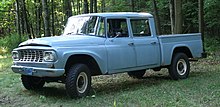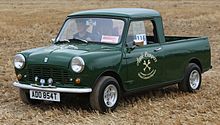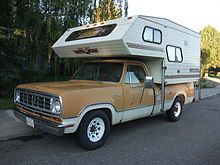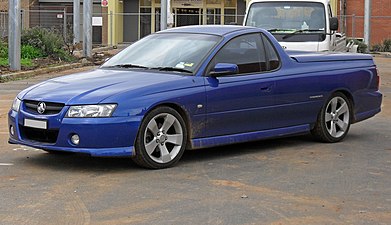Pickup truck

Apickup truckorpickupis alight or medium duty truckthat has an enclosedcabin,and a back end made up of a cargo bed that is enclosed by three low walls with no roof (this cargo bed back end sometimes consists of atailgateand removable covering).[1]InAustraliaandNew Zealand,both pickups andcoupé utilitiesare calledutes,short forutility vehicle.InSouth Africa,people of all language groups use the termbakkie;a diminutive ofAfrikaans:bak,meaningbowlorcontainer.[2]
Once a work or farming tool with few creature comforts, in the 1950s, US consumers began purchasing pickups for lifestyle reasons, and by the 1990s, less than 15 percent of owners reported use in work as the pickup truck's primary purpose.[3]In North America, the pickup is mostly used as apassenger car[4]and accounts for about 18% of total vehicles sold in the United States.[5]Full-sized pickups andSUVsare an important source of revenue for major car manufacturers such asFord,General Motors,andStellantis,accounting for more than two-thirds of their global pre-tax earnings, though they make up just 16% of North American vehicle production. These vehicles have a highprofit marginand a high price tag; in 2018, Kelley Blue Book cited an average cost (including optional features) of US$47,174 for a new Ford F-150.[6]
The term pickup is of unknown origin. It was used byStudebakerin 1913. By the 1930s, it had become the standard term in certain markets for a light-duty truck.[7][unreliable source]
History
[edit]

In the early days of automobile manufacturing, vehicles were sold only as achassisand third parties added bodies on top.[8]In 1902, theRapid Motor Vehicle Companywas founded by Max Grabowsky and Morris Grabowsky who built one-ton carrying capacity trucks in Pontiac, Michigan. In 1913, theGalion Allsteel Body Company,an early developer of the pickup anddump truck,built and installed hauling boxes on slightly modifiedFord Model Tchassis,[9]and from 1917, on theModel TT.Seeking part of this market share,Dodgeintroduced a 3/4-ton pickup with a cab and body constructed entirely of wood in 1924.[10]In 1925, Ford followed up with a steel-bodied half-ton based on the Model T with an adjustabletailgateand heavy-duty rear springs.[11]Billed as the "Ford Model T Runabout with Pickup Body," it sold forUS$281;34,000 were built. In 1928, it was replaced by theModel A,which had a closed-cab, safety-glass windshield, roll-up side windows, and three-speed transmission.
In 1931, General Motors introduced light-duty pickups for bothGMCandChevrolettargeted at private ownership. These pickup trucks were based on theChevrolet Master.In 1940, GM introduced the dedicated light-truck platform, separate from passenger cars, which GM named theAK series.[12]Ford North America continued to offer a pickup body style on theFord Model 51,and the Ford Australian division produced the first Australian"ute"in 1932.[13]In 1940, Ford offered a dedicated light-duty truck platform called theFord F-100,then upgraded the platform afterWorld War IIto theFord F-Seriesin 1948.
Dodge at first assumed heavier truck production fromGraham-Paige,while the company produced their light (pickup) trucks, initially on their sufficiently sturdy passenger car frames. But after switching to distinct, dedicated truck frames in 1936, Dodge/Fargo launched an extensive own truck range for 1939, marketed as the"Job-Rated" trucks.TheseArt Deco–styled trucks were again continued after World War II.
International Harvesteroffered theInternational K and KB series,which were marketed towards construction and farming and did not have a strong retail consumer presence, andStudebakeralso manufactured theM-series truck.At the beginning of World War II, the United States government halted the production of privately owned pickup trucks, and all American manufacturers builtheavy duty trucksfor the war effort.[12]
In the 1950s, consumers began purchasing pickups for lifestyle rather than utilitarian reasons.[12]Car-like, smooth-sided, fenderless trucks were introduced, such as the Chevrolet Fleetside, theChevrolet El Camino,the Dodge Sweptline, and in 1957, Ford's purpose-built Styleside. Pickups began to feature comfort items such as power options and air conditioning.[3]During this time, pickups with four doors, known as crew cabs, started to become popular. These pickup trucks were released in 1954 in Japan with theToyota Stout,[14][15]in 1957 in Japan with theDatsun 220,and in 1957 in America with theInternational Travelette.[16]Other manufacturers soon followed, including theHino Briskain 1962, Dodge in 1963,[17]Fordin 1965, andGeneral Motorsin 1973.[18]
In 1961 in the UK theBritish Motor Corporationlaunched an AustinMini Pickupversion of the original 1959 Mini. It was in production until 1983.

In 1963, the USchicken taxdirectly curtailed the import of theVolkswagen Type 2,distorting the market in favor of US manufacturers.[19]The tariff directly affected any country seeking to bring light trucks into the United States and effectively "squeezed smaller Asian truck companies out of the American pickup market."[20]Over the intervening years, Detroit lobbied to protect the light-truck tariff,[19]thereby reducing pressure on Detroit to introduce vehicles that polluted less and that offered increased fuel economy.[19]
The US government's 1973Corporate Average Fuel Economy(CAFE) policy set higher fuel-economy requirements for cars than pickups. CAFE led to the replacement of thestation wagonby theminivan,the latter of which belonged in the truck category, which allowed it to comply with less strict emissions standards. Eventually, CAFE led to the promotion ofsport utility vehicles(SUVs).[21][22]Pickups, unhindered by the emissions controls regulations on cars, began to replacemuscle carsas the performance vehicle of choice. TheDodge Warlockappeared in Dodge's "adult toys" line,[3]along with the Macho Power Wagon and Street Van. The 1978gas guzzler tax,which taxed fuel-inefficient cars while exempting pickup trucks, further distorted the market in favor of pickups. Furthermore, until 1999, light trucks were not required to meet the same safety standards as cars,[23]and 20 years later, most still lagged behind cars in the adoption of safety features.[24]
In the 1980s, the compactMazda B-series,Isuzu Faster,andMitsubishi Fortedebuted. Subsequently, US manufacturers built their compact pickups for the domestic market, including theFord Ranger,and theChevrolet S-10.Minivansmake inroads into the pickups' market share.[3]In the 1990s, pickups' market share was further eroded by the popularity of SUVs.[3]
Mid-sized electric trucks had been tried early in the 20th century[25]but soon lost out to gasoline and diesel vehicles. In 1997, theChevrolet S-10 EVwas released, but few were sold, and those were mostly to fleet operators.[26]
By 2023, pickup trucks had become strictly more lifestyle than utilitarian vehicles. Annual surveys of Ford F-150 owners from 2012 to 2021 revealed that 87% of the owners used their trucks frequently for shopping and running errands and 70% for pleasure driving, whereas 28% used their trucks often for personal hauling (41% occasionally and 32% rarely/never) and only 7% used them for towing while 29% only did so occasionally and 63% rarely/never did. The 1960s–1970s Ford F-100 was typically a regular cab and consisted of mostly 64% bed and 36% cab, while by mid-2000s, crew cabs were largely becoming the norm and the bed was shrunk to accommodate the larger cab, and a 2023 F-150 consisted of 63% cab and 37% bed.[27]
International markets
[edit]While theFord F-150has been thebest-selling vehicle in the United Statessince 1982,[28]the Ford F-150, or indeed any full-sized pickup truck, is a rare sight in Europe, where higher fuel prices and narrower city roads make it difficult to use daily.[29]In the United States, pickups are favored by a cultural attachment to the style, lower fuel prices, and taxes and regulations that distort the market in favor of domestically built trucks.[19]As of 2016, theIRSofferstax breaksfor business use of "any vehicle equipped with a cargo area... of at least six feet in interior length that is not readily accessible from the passenger compartment".[30]
In Europe, pickups represent less than 1% of light vehicles sold,[31]the most popular being theFord Rangerwith 27,300 units sold in 2015.[32]Other models include the Renault Alaskan (a rebadgedNissan Navara), and theToyota Hilux.
TheNOx lawand other differing regulations prevent pickups from being imported to Japan, but theJapanese domestic marketMitsubishi Tritonwas available for a limited time. The most recent pickup truck for sale in Japan is theToyota Hilux.
In China (where it is known by the Englishloanwordas bì tạp xa pí kǎ chē), theGreat Wall Wingleis manufactured domestically and exported to Australia.[33]In Thailand, pickups manufactured for local sale and export include theIsuzu D-Maxand the Mitsubishi Triton. In Latin and South America, theToyota Hilux,Ford Ranger,VW Amarok,Dodge Ram,Chevrolet S-10,Chevrolet D-20,andChevrolet Montanaare sold.
InSouth Africa,pickups account for about 17% of the passenger and light commercial vehicle sales, mostly the Toyota Hilux,Ford Ranger,and Isuzu KB (Isuzu D-Max).[34]TheVolkswagen AmarokandNissan Navaraare also sold.
Design and features
[edit]
In the United States and Canada, nearly all new pickups are sold withautomatic transmissions.Only theJeep Gladiatorand theToyota Tacomaare available with manual transmissions.[35]
A regular cab, single cab or standard cab, has a single row of seats and a single set of doors, one on each side.
Extended cab or extra cab pickups add an extra space behind the main seat, sometimes including smallerjump seatswhich can fold out of the way to create more storage space. The first extended-cab truck in the United States was called theClub Caband was introduced by Chrysler in 1973 on its Dodge D-series pickup trucks. Extended-cab trucks either have just a single set of doors with no direct access to the extended portion of the cab, very small (half-sized) rear doors that are rear-hinged which can only be opened after the front doors are open, or small (three-quarter-sized) front-hinged doors.
A crew cab, or double cab, seats five or six and has four full-sized, front-hinged doors. The first crew-cab truck in the United States was made by International Harvester in 1957 and was later followed by Dodge in 1963, Ford in 1965, and Chevrolet in 1973. However, they were originally available only with three-quarter-ton or one-ton models (such as Ford F-250/F-350), while half-ton trucks like Ford F-150 would not become available in four-door configuration until 2001, by which time crew cabs also started overtaking regular/extended cabs in popularity.[27]
Cab-overorcab forwarddesigns have thecabsitting above the frontaxle.This arrangement allows a longer cargo area for the same overall length. An early cab-forward, drop-sided pickup was theVolkswagen Transporter,introduced in 1952. This configuration is more common among European and Japanese manufacturers than in North America. The design was more popular in North America in the 1950s and 1960s, with examples including theChevrolet CorvairRampside and Loadside,Dodge A-100 and A-108,Ford Econoline,andJeep FC-150 and FC-170.
A "dually" is a North American colloquial term for a pickup with four rear wheels instead of two, able to carry more weight over the rear axle. Vehicles similar to the pickup include thecoupé utility,a car-based pickup, and the larger sport utility truck (SUT), based on asport utility vehicle(SUV).
The terms half-ton, three-quarter-ton, and one-ton are remnants from a time when the number referred to the maximum cargo capacity by weight.[36]
In North America, some pickup trucks may be marketed as heavy duty (egRam Heavy Duty), super duty (egFord Super Duty) or simply "HD". This is typically a pickup truck with higher payload and/or towing capabilities than is standard for their size. While synonymous with "dually" orfull-size pickup trucksin North American, none of those are requirements. Dually is not available on Ram 2500 or Ford F-250 and is optional on Ram 3500 or Ford F-350, but those pickup trucks are all heavy duty.[37][38]Mahindra Bolero MaXX Pik-Up HD is a heavy dutymid-size pickup truckwith a two tonne payload.[39]
Some pickup trucks have an opening at the rear of the cab to increase cargo capacity lengthwise without increasing overall vehicle length or wheelbase, which reduces break over, approach, departure angles and increases turning radius. This feature is referred to as a mid-gate due to it being located in the middle of a pickup truck, as opposed to the tail-gate, which is located as the rear/tail of the vehicle.[40]
Bed styles
[edit]The cargo bed can vary in size according to whether the vehicle is optimized for cargo utility or passenger comfort. Most have fixed side walls and a hinged tailgate. Cargo beds are normally found in two styles: stepside or fleetside. A stepside bed has fenders that extend on the outside of the cargo area; originally these were just fenders attached to a cargo box. This style used to be the standard design, as it was cheaper to manufacture. A fleetside bed has wheel wells inside of a double-walled bed, and most are usually designed to match the cab's styling. The two types of bed have been given a variety of names by different manufacturers; "Stepside" and "Fleetside" originate with Chevrolet but are also frequently used by Dodge as well as GMC. GMC has also used "Wideside" instead of Fleetside, while Dodge has also used "Utiline" and "Sweptline" for the two types. Ford uses "Flareside" and "Styleside", respectively. Jeep has used "Sportside" and "Thriftside" for the separate fender style, and "Townside" for flush designs.[41]International Harvester called the two types "Standard" and "Bonus-Load".
The first fleet-sided pickup truck was theCrosleyin the 1940s,[citation needed]followed by the 1955Chevrolet Cameo Carrier.Early pickups had wood-plank beds, which were largely replaced by steel by the 1960s. In many parts of the world, pickups frequently use a dropside bed – with a flat tray with hinged panels that can be raised separately on the sides and the rear. The fleetside has gradually fully replaced the earlier, separate-fender look: The last time Chevrolet and GMC used the Stepside style was on the 2005 Silverado and Sierra 1500 models; Ford last used the Flareside style on the 2009 F-150.
Safety
[edit]Consumer pickup trucks sold in the US have increased in weight by 32% since 1990.[42]Also, cabins have grown and risen further from the ground and grill and hood sizes have increased over time. These changes mean that a modern standard pickup truck has a 2.1–3.0 m (7–10 ft) longer blind spot in front of its grill than most other vehicles as well as increased blind spots behind and to the side. TheFord F-250has a hood almost 1.8 m (6 ft) from the ground. It may be impossible to see a small object such as a child as far as 4.6 m (15 ft) in front of the vehicle.[43]A total of 575 children in the US died in front-over deaths between 2009 and 2019, most by their parents. This is an 89% increase in mortality from the previous ten years. Additionally, US car-related fatalities went up by 8% and pedestrian casualties increased by 46% between 2011 and 2021. While the reasons for this increase are complex, Consumer Reports partially attributes this number to increased truck size and prevalence.[44]Chuck Farmer from the USInsurance Institute for Highway Safetyhas found large pickup trucks to be as deadly or deadlier than muscle cars and "... are work trucks, and people should not be using them primarily for commuting, because they kill so many other drivers."[45]
Uses
[edit]
In the United States and Canada, pickups are used primarily for passenger transport. Pickup trucks are often marketed and used for their hauling (utilizing cargo bed) and towing (utilizing body-on-frame design and long wheelbase) capabilities.
Pickup trucks are also used by manyjourneymen,tradesmen,andoutdoor enthusiasts.They are also used to move or transport large goods. For example, in the US, a homeowner can rent a pickup truck to transport a large appliance from a home supply store.
Equipping pickup trucks with acamper shellprovides a small space forcamping.Slide-intruck camperscan offer a pickup truck the amenities of a smallmotorhome,but still allow the operator the option of removal and independent use of the vehicle.[46]
Pickups are popular withoverlandersas they are often the most affordable vehicle capable of carrying the large quantities of fuel needed for long distance, remote travel and generator use without expensive modifications.
Modified pickups can be used as improvised, unarmored combat vehicles called atechnical.
Pickup trucks are used to carry passengers in parts of Africa and Southeast Asia. In Thailand, mostsongthaewsare converted pickup trucks and flatbed trucks. In Haiti,tap tapsare also converted pickup trucks.
Towing with pickup trucks is separated into two categories: conventional towing (bumper pull) and in-bed (heavy duty) towing. Conventional towing mounts the hitch at the rear of the pickup truck, in-bed towing mounts the hitch directly above or in front of the rear axle.Weight distribution hitchfalls under conventional towing.Fifth wheel and gooseneckfall under in-bed towing.
Sizes
[edit]Kei/Mini truck
[edit]Kei trucks are a Japanese class with a maximum length of 3,400 mm (134 in), a maximum width of 1,480 mm (58 in), a maximum height of 2,000 mm (79 in), and a maximum displacement of 660 cc (40 cu in).[47][48]
In some countries, mini trucks are similar to, or slightly bigger than, kei trucks. In other countries, eg the United States, mini trucks are another name for any pickup smaller than full-size pickups.[citation needed]
UTVsare of similar size and serve similar roles in developed countries but are typically restricted to off-road and rural areas.[49]
Compact pickup truck
[edit]Typically, aunibodypickup truck is built oncompact SUVplatformor a compact passenger car platform. Examples include theHyundai Santa CruzandFord Maverick.Subarualso produced theSubaru Bajabased heavily on theSubaru Outback(Legacy)wagonandSubaru BRATbased on theSubaru Leonewagon using a unibody construction.[50][51]Other variations include theHolden CrewmanandHolden one tonnerwhich are based on asedan platformbut use a part-monocoque,partchassis frameconstruction.[52][53]
Mid-size pickup truck
[edit]Typically, abody-on-framepickup truck of a similar size to amid-size SUV.Examples include theFord Ranger,Toyota Hilux,andIsuzu D-Max.This is usually the largest size pickup sold or manufactured in countries outside North America.
Full-size pickup truck
[edit]Abody-on-framepickup truck with an exterior width of more than two meters (excluding mirrors and/or widebody/flares fordually wheels).
Gallery
[edit]-
Early compactDatsun Truck
-
Volkswagen Type 2with singlecab overand a drop side bed with the left panel folded down
-
1961Chevrolet Apachewith a step-side bed
-
Chevroletflatbedwith four wheels on the rear axle ( "dually" ) for improved towing
-
Ford F-250 extended cab fitted with an aftermarket utility bed
-
Songthaewconversion
-
1990Suzuki Carry,aKei truck
-
2006Holden Ute,a car-basedcoupé utility
-
Ford Rangerdouble cab in FrenchNational Gendarmerielivery
-
Chevrolet Colorado flat-sided pickup truck showing wheel well intrusion into bed
-
Nissan Titanshowing the function of an extended cab's rear-hinged doors
See also
[edit]- Flatbed truck
- Kei truck
- List of pickup trucks
- Panel van
- Pickup truck racing,a form ofauto racingusing modified versions of pickups mostly onoval tracks
- Roadster utility
- Rolling coal:some pickups are modified to produce morediesel exhaust.[54]Modifications may cost from $2,000 to $5,000.[55][56]
- Self-driving truck
- Cutaway van chassis
- Chassis cab
References
[edit]- ^"Pickup".Merriam Webster.Retrieved7 August2014.
- ^"bakkie - definition of bakkie in A Dictionary of South African English - DSAE".dsae.co.za.Retrieved5 October2023.
- ^abcdeMueller, Mike.The American Pickup Truck.p. 9.ISBN9780760304730.
- ^Porter, Bryan, ed. (2011).Handbook of Traffic Psychology.Elsevier. p. 222.ISBN9780123819840.
- ^"Vehicle Registration Data".Hedges & Company.Retrieved6 February2016.
- ^Matt, Degan (22 August 2018)."Pricing Your Next Ford F-150: It Could Cost $60,000 – or More".Kelley Blue Book.
- ^Zuehlke, Jeffrey (2007).Pickup Trucks.LernerClassroom.p. 9.ISBN978-082256564-2.
- ^Mueller, Mike.Classic Pickups of the 1950s.
- ^"Encyclopedia of American Coachbuilders & Coachbuilding".Coachbuilt.Retrieved10 April2012.
- ^"1918 to 1928 Dodge Brother Pickups".Archived fromthe originalon 8 March 2019.Retrieved26 May2015.
- ^"The History of Ford Pickups: The Model T Years 1925–1927".PickupTrucks.com.Archived fromthe originalon 30 November 2010.Retrieved4 June2009.
- ^abc"Trucking Timeline: Vintage and Antique Truck Guide".Retrieved26 May2015.
- ^"Australia Innovates: The Ute: 1934 vehicle with car cabin and utility tray".Powerhouse Museum.Retrieved4 October2021.
- ^"Toyota Vehicle Identification Manual", Toyota Motor Corporation, Overseas Parts Department, Catalog No.97913-84, 1984, Japan
- ^"Toyota Truck 48HP brochure No. 228".Toyota.Japan. 1954.Retrieved17 June2011.
- ^"The Evolution Of The Great American Pickup Truck, From 1925 To Today".Daily Detroit.22 April 2017.Retrieved13 November2020.
- ^"The 2007 Jeep Wrangler".Allpar.Archived fromthe originalon 6 September 2007.Retrieved4 June2007.
- ^"Chevrolet Avalanche press release"(Press release). Archived fromthe originalon 14 June 2007.Retrieved4 June2007.
- ^abcdBradsher, Keith (30 November 1997)."Light Trucks Increase Profits But Foul Air More than Cars".The New York Times.Retrieved28 April2010.
- ^Hunting, Benjamin (10 March 2009)."Global Vehicles and Thailand Argue Against 'Chicken Tax' On Imported Pickups".Autobytel.
- ^Brown, Warren (13 April 2007)."Greenhouse Real Wheels".The Washington Post.Retrieved22 June2007.
- ^Brown, Warren (29 August 2004)."The Station Wagon Stealthily Returns".The Washington Post.Retrieved22 June2007.
- ^Eddington, Julia (16 July 2015)."Why Trucks Aren't as Safe as Cars".The Zebra.Retrieved29 October2019.
- ^Atiyeh, Clifford (21 March 2019)."Three Pickup Trucks Ace IIHS Crash Tests, Yet Many Aren't As Safe As They Should Be".Car and Driver.Retrieved29 October2019.
- ^"Electric truck".Autocar.US. 14 June 1923.Retrieved1 October2022.
- ^Stumpf, Rob (13 December 2019)."Forget the Cybertruck: Get Yourself a Factory 1997 Chevrolet S-10 Electric Pickup".The Drive.Retrieved1 October2022.
- ^ab"Pickup trucks have gotten bigger, higher-tech — and more dangerous".axios.com.Retrieved2 February2023.
- ^"Auto sales reach six-year high of 15.6 million vehicles sold, Ford F-Series takes the lead".NY Daily News.6 January 2014.
- ^"How Do Europeans View the Ford F-150 Pickup Truck?".Carscoops.6 June 2013.Retrieved20 June2015.
- ^"Electing the Section 179 Deduction".IRS.Retrieved21 December2016.
- ^Mirani, Leo (31 March 2015)."Mercedes is making a fancy pickup truck—for Europeans".Retrieved30 September2016.
- ^Miller, Daniel (30 September 2016)."Europe's Best-Selling Pickup Might Surprise Americans".The Motley Fool.Retrieved30 September2016.
- ^"Chinese Pickup Truck Sales, Led by Great Wall Wingle, Surged 48% to 378,000 Units in 2010".ChinaAutoWeb.com.Archived fromthe originalon 4 August 2012.Retrieved25 January2024.
- ^"Hilux dethroned: SA has new top bakkie".Wheels.2 December 2014.Retrieved6 February2016.
- ^Mays, Kelsey (16 July 2021)."Which New Cars Have Manual Transmissions?".Cars.com.Retrieved8 October2021.
- ^"Pickup truck buying guide".Consumer Reports.Archived fromthe originalon 27 May 2015.Retrieved28 August2022.
- ^"2024 Ford Super Duty® Truck | Pricing, Photos, Specs & More".
- ^"Ram Trucks Australia - 2500/3500 Laramie Crew Cab".Ram Trucks Australia.Retrieved13 April2024.
- ^"maxx-hd".auto.mahindra.com.India.Retrieved13 April2024.
- ^"Great Moments in Midgate History".
- ^Rupp, Steven (19 February 2021)."Stepside vs Fleetside Truck Beds and What's the Difference?".Hot Rod.Motor Trend Group, LLC. Archived fromthe originalon 13 June 2021.
- ^DeGood, Kevin [@kevin_degood] (27 August 2019)."Weight of pickup trucks since 1990"(Tweet).Retrieved11 April2023– viaTwitter.
- ^Segall, Bob (25 April 2019)."Millions of vehicles have unexpected, dangerous front blind zone".Wthr.com.Retrieved11 April2023.
- ^Kieth, Barry (8 June 2021)."Which New Cars Have Manual Transmissions?".Consumer Reports.US.Retrieved11 April2023.
- ^Samilton, Tracy (14 July 2023)."American muscle cars, large pickups, are most deadly vehicles on road, insurance institute finds".Michigan Radio.Retrieved16 July2023.
- ^Stimson, Tom (May 1967)."Campers, 12 ways to add comfort and convenience".Popular Mechanics.Vol. 127, no. 5. pp. 124–127, 228.Retrieved11 May2016.
- ^"Daihatsu Hijet Truck (S500 series)".J-Spec Imports.Australia.Retrieved17 December2023.
- ^Hawley, Dustin (24 November 2022)."What Is A Kei Truck?".J.D. Power.US.Retrieved17 December2023.
- ^"Ultra-light utility vehicle: Registration, uses and equipment".NSW Government.New South Wales, Australia.29 January 2021.Retrieved27 February2024.
- ^"All SUBARU Baja Models by Year (2003-2006) - Specs, Pictures & History".autoevolution.Retrieved16 July2024.
- ^Niedermeyer, Paul (26 February 2021)."Curbside Classic: 1982 Subaru BRAT - The Young Man's Choice Of Pickup In Those Terrible Times".Curbside Classic.Retrieved16 July2024.
- ^"MODELS info".Crewman.Retrieved16 July2024.
- ^NEWTON, GoAutoMedia-BRUCE."First look: One-Tonner back in black".GoAuto.Retrieved16 July2024.
- ^Abel, David (28 July 2014)."Rules have diesel enthusiasts fuming".The Boston Globe.Retrieved11 May2016.
- ^Dahl, Melissa (24 July 2014)."Why Pickup Truck Drivers Are Paying $5,000 to Pollute More".Science of Us.Retrieved11 May2016.
- ^Kulze, Elizabeth (16 June 2014)."'Rollin' Coal' Is Pollution Porn for Dudes With Pickup Trucks ".Vocativ.Retrieved11 May2016.
Further reading
[edit]- Wakely, Joel (2022).The Passion for Utes: An Australian Obsession.Warriewood, NSW: Woodslane Press.ISBN9781925868968.
External links
[edit]![]() Media related toPickup trucksat Wikimedia Commons
Media related toPickup trucksat Wikimedia Commons













